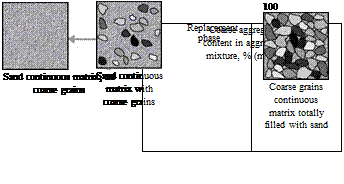30-20-10 rule
The 30-20-10 rule suggests that proper stone-to-stone contact is created if the percentages of aggregate passing sieves of 0.075 mm, 2.36 mm, and 4.75 mm equal 10%, 20%, and 30%, respectively, which should provide for the appropriate discontinuity in the gradation. After comparing this rule with the data of Table 6.4, one can see that the proportion of grains larger than 4.75 mm from this rule (70%, or 30% passing the
|
TABLE 6.4 Approximate Contents of Aggregate Fractions for Zichner’s Mastimac and Mastiphalt
(SMA 0/12.5) Source: Based on Zichner, G., MASTIMAC unad MASTIPHALT bituminose Gemische fur hochwer – tige Deckschichten. STRABAG Schriftenreihe 8, Folge 4, 1972. |
 |
 |
FIGURE 6.1 Relationship between contents of voids in the aggregate mix and the coarse aggregate fraction. (Based on Ferguson, A., Fordyce, D., and Khweir, K., Proceeding of the Third European Symposium on Performance and durability of bituminous Material and Hydraulic Stabilised Composites, AEDIFCATIO publishers, D-79104 Freiburg i. Br. and CH-8103 Unterengstringen/Zurich, 1999; Francken, L. and Vanelstraete, A., Proceeding of Eurobitume Congress Stockholm, Sweden, 1993; Lees, G., Journal of the Association of Asphalt Paving Technologists, 39, 1969; van de Ven, M. F.C., Voskuilen, J. L.M., and Tolman, F., The Spatial approach of hot mix asphalt. Proceedings of the 6th RILEM Symposium PTEBM’03, Zurich 2003.
each other (a skeleton of coarse grains has been formed and is filled with fine grains); the replacement phase has come to an end.
• Then follows the reverse direction of changes in the contents of voids—the mixture becomes open by means of gradually removing the fine aggregate among coarse grains up to 100% (m/m) coarse aggregate when the highest content of voids is reached; that process could be named the filling phase.
The aforementioned relationship between the amount of air voids and gradation of the coarse aggregate fraction directly translates into the binder content in SMA (Druschner and Harders, 2000; Schroeder and Kluge, 1992). The difference in the binder content, which is dependent on the content of grains larger than 2 mm, has been proved in the previously mentioned German publications (and many others published in Germany). In these examples of tested SMA mixes, the optimum binder content in an SMA mixture depended on the coarse fraction content. For example, with 73% (m/m) of coarse particles content and air voids at the level of 3% (v/v), the binder content amounts to 5.5% (m/m); after an adjustment of the aggregate mix and an increase in the content of coarse aggregate up to 80% (m/m), the same 3% (v/v) of air voids are achieved at a binder content of about 7% (m/m). These results were achieved with the use of a Marshall hammer with a compaction effort of 2 x 50 strokes.
This relationship among contents of binder, air voids, and the coarse aggregate fraction establishes a rule that the content of voids in a designed SMA mixture should not be adjusted by changing the binder content. There is a much higher potential for changing the air voids by adjusting the content and gradation of the coarse aggregate fraction or, generally, by altering the gradation curve.






Leave a reply